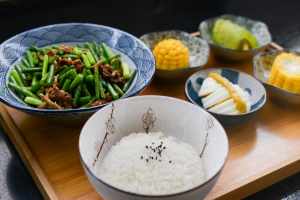Are you a rice lover? But are you conscious about your health too? Well, then start reading our blog below. We will give you a complete idea about white rice nutrition facts and many more things you must be aware of. We will not only discuss about carbs, minerals, and protein in white rice, but we will also tell you some risks associated with it. Read on if you want to know everything about white rice!
Table of Contents
Why is rice a famous grain?
Before we get into white rice nutrition facts, let us see why it is a famous grain globally!
Rice is necessary for most of the world’s population. More than half of the world depend on rice. Asia supplies almost all the rice to the world as a whole. It is a staple food for many, and you will find that rice is among the world’s oldest most cereal grains.
There are many types of rice. Among which white rice and brown rice are the most common. Brown and white rice have several nutrients present in them. 1 cup cooked white rice nutrition is so high that you will remain energized the entire day. However, there are several risks if it is eaten excessively! And to make you aware, we have covered everything you need to know! Hang in there if you want to know more about white rice nutrition facts and side effects.

White rice nutrition facts
Rice can be divided into two groups – brown and white. The most popular one among the two is white rice. White rice has both protein and carbohydrates. If you cook rice, you will find that 70% of its total weight consists of water. So, it is evident that you get a large amount of water in the cooked rice. Cooked, short-grain, white rice of 100 grams has 130 calories, 28.7 grams of carbohydrate, 2.36 grams of protein, and 0.19 grams of fat. Below we have discussed in details the white rice nutrition facts:
Carbohydrate
Among the white rice nutrition facts, one of the primary contents is carbohydrates. Starch is a popular carbohydrate form. You will find starch in rice mostly. You will notice that starch consists of two types of glucose, which is amylopectin and amylose. And you will find these two types of glucose form in long chains in the starch. However, you must know that all rice types are different. For instance:
- Basmati rice is not sticky after cooking due to the presence of a high amount of amylose.
- After cooking, glutinous rice is sticky due to the low amount of amylose and high amylopectin. This glutinous rice or sticky rice is perfect for rice pudding, risottos and you can also have it with chopsticks if you want.
Now we are coming to your digestion process of different types of rice. Your body can digest sticky rice or glutinous rice without any problem in a short time. But in the case of high amylose rice, for instance, basmati rice, amylose reduces starch digestion in your body, so it takes a long time to digest. If you have diabetes, sticky rice can increase your levels of blood sugar due to its quick digestion process.

Fiber
After carbohydrate, we are coming to the fiber content present in white rice. When you process the white rice, you lose the seed coat or bran. These parts contain the maximum amount of fiber. The bran does not contain any soluble fiber, and it primarily has insoluble fibers. White rice has resistant starch. Resistant starch is a soluble fiber. Now let us discuss the function of the resistant starch. Resistant starch raises your gut butyrate.
Fiber can give you constipation relief. It can also help you to:
- Manages your weight
- Lower your levels of cholesterol
- Decreases your diabetes risk
- Decreases your risk of heart diseases
- Nourish your bacteria of the gut
If you are a man under 50 years of age, you have to take fiber 38g each day for great health. But if you are a man above 51 years of age, it is best you have 30g of fiber each day. But it is different in the case of women!
If you are a woman under 50 years of age, you have to take fiber 25g each day. And if you are a woman above 51 years of age, you have to take fiber 21g each day.
Your fiber amount depends on many factors like your caloric intake and age. You should consult a good doctor to ensure your fiber amount is sufficient for you.
Folate
Now let us discuss the folate content in white rice! White rice is rich in folate. You can find, on average, 1 cup cooked white rice nutrition can supply you with 195 to 222 micrograms (mcg) of folate content. Folate is an essential nutrient for you. It is mainly vital for pregnant women. Folate can make your body produce genetic materials like DNA and make your body support the process of cell division.
However, you should consult a doctor about the folate amount you need to intake. Generally, adults can take 400 mcg of folate daily. Pregnant women and breastfeeding women need to have 600 mcg and 500 mcg of folate, respectively.
Fat
You will not find any fat in the rice. But if you add butter to your rice, you will add fat into its nutritional value.
Protein
Protein in white rice is massive. One cup can supply you with four grams of protein. Isn’t that amazing?
Manganese
Manganese is essential for your metabolism system, antioxidant system, growth, and development. And you will get some amount of manganese from white rice.
Niacin
You can find in rice niacin is in nicotinic acid form. Another name of niacin is vitamin B-3. You can also get this nutrient from white rice.
Thiamin
Thiamin is essential for your nervous system, muscles, proper heart function, and metabolism. Another name of thiamin is vitamin B-1. White rice has the presence of this as well.
Selenium
Selenium has many vital functions for your hormones, oxidative damage, and DNA. So, consuming selenium is necessary for your health overall. And to do that, include white rice into your diet.
Magnesium
Magnesium is essential for your energy, protein synthesis, blood pressure, and more. And you can get some amount of magnesium from white rice.
1 cup cooked white rice nutrition
Now let us quickly take a glance at the white rice nutrition facts below for one cup of cooked rice:
[table id=34 /]
Moreover, rice also has some phosphorus, vitamin B-6, pantothenic acid, riboflavin, and copper.
However, white rice, after processing, loses the seed coat or bran. So, after processing, it improves in taste and cooking quality, but its nutritional value decreases.
Consequently, this processing lowers the content of fiber in white rice. So, it is always advisable to consult your doctor to check you are getting an adequate amount of fiber. If you have diarrhea, diverticulitis, gastrointestinal tract surgery, colorectal cancer blockage, inflammatory bowel disease, always speak to your doctor before making any changes in your diet.
Side effects of white rice
Many countries have rice as their staple food. Now you know about the white nutrition facts, so it is evident that it offers several benefits. But it does have some side effects as well.
If you eat rice daily in large amounts, you have several risks. Some of the side effects of white rice are as follows:
May increase your metabolic syndrome risks
Some of the metabolic syndrome diseases are type 2 diabetes, heart disease, and stroke. Overconsumption of white rice can lead to a large waistline, high blood pressure, good HDL cholesterol, low levels, high levels of triglyceride, and high blood sugar. You will find in several studies that Asian adults, due to eating high amounts of white rice, have a high metabolic syndrome risk. So you should avoid eating white rice in large quantities to stay healthy. It is essential to keep a note of this intake.

Type 2 diabetes
White rice can raise your type 2 diabetes risk due to its high glycemic index. It can increase your level of blood sugar after you eat a meal. You should avoid foods that possess a high glycemic index because it can raise your diabetes risk. So, if you want to decrease this risk and stay healthy, you should control eating white rice. Even if you like to eat white rice daily, you need to limit it.
Arsenic contamination
Arsenic contamination is an important issue. All types of rice can get arsenic contaminated. Older adults and pregnant women primarily should not eat rice cereals or rice for its arsenic contamination. It is dangerous for them and their babies. So if they want to stay safe along with their children, they must avoid using white rice. You cannot excrete a hefty metal like arsenic quickly that your body takes a lot of time to accumulate in it. All adults should eat various grains and food that do not contain arsenic.
Enterocolitis syndrome
White rice causes enterocolitis syndrome. You can see this disease mainly in small children and babies. So the parents must be careful about this. It may look like an allergy to you, but it is not actually an allergy. It is the large and small intestine inflammation. So, you should know some of the symptoms of this disease. Some of the symptoms are diarrhea, vomiting. However, if it is severe, it may even give a shock.
Reheating rice
If you store and reheat the white rice, you have a high food poisoning risk. If you do not want to take this risk, you should cook rice for only one meal daily. This is the best thing for you to do. But if you have an emergency and need to store rice for some other meal, you must follow a few things. Here are the quick tips to keep in mind:
- You have to cool the rice immediately. Make sure that the time does not exceed an hour.
- Do not refrigerate the rice for more than 24 hours.
- You have to make sure that the whole rice is hot when you reheat it.
- Do not reheat the same rice again for the second time.
These are the things you have to keep in mind if you want to store the rice for another meal. Otherwise, you have a high food poisoning risk.
Weight gain
If you do not exercise regularly and eat large amounts of rice, you can undoubtedly gain weight. You must avoid eating a lot of rice to maintain your weight because rice contains high amounts of carbohydrates and starch. If you want to maintain your weight, then you should avoid eating rice in large quantities daily. This is a critical issue of eating white rice.
Allergy
You may find some people who have rice allergies. Mostly, rice allergy is mainly seen in Asian countries where rice is an essential food. However, rice allergy is very rare. If you eat a large amount of white rice regularly, it may cause an allergy in you. So you must be extremely careful while having white rice every day.
Kidney disease
You have to control having too much rice. If you eat a lot of rice, you may suffer from kidney disease. Since overconsumption can increase the chances of diabetes, you might suffer from kidney-related problems as well. Moreover, consuming too much can cause a hindrance to proper kidney function. However, white rice is better to some extent in comparison to any other type of rice in this case.
Final Thoughts
White rice nutrition facts are enormous. But it does have various advantages and disadvantages. It keeps you healthy, and it also has many risks. Now that you know all the risks avoiding them and protecting yourself from several diseases will be easy. So, minutely follow them and consume them in moderation to allow the goodness to do a marvelous spell on your health overall.
